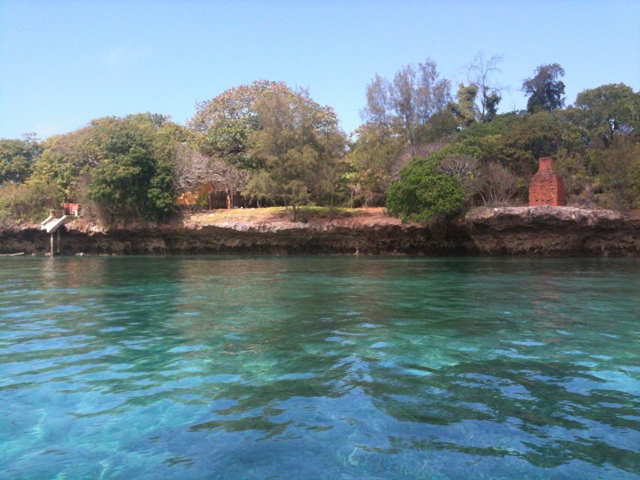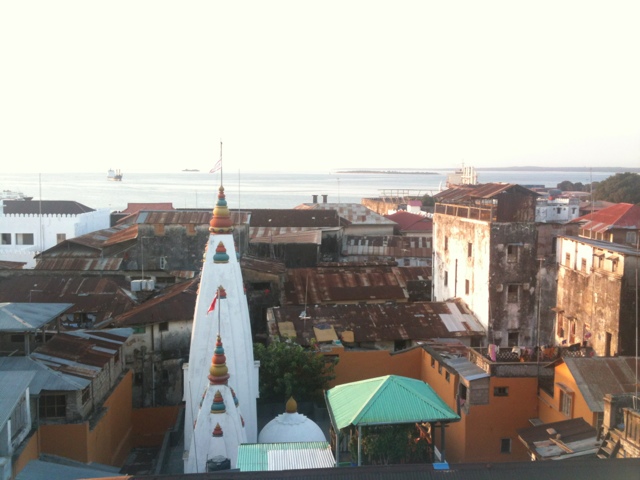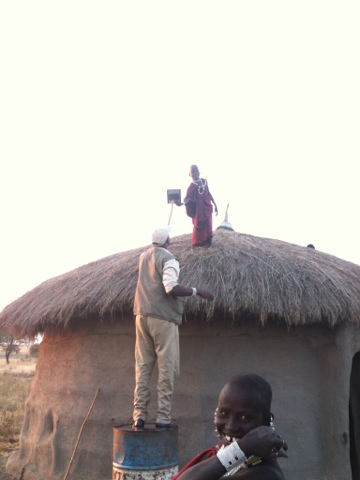The last day was perfect, though. I didn't think we could end on such a high note.
We woke up on the later side (this whole Zanzibar leg has been like that though, wake-ups at 7 or 8 instead of 4am) and had a leisurely breakfast on the roof. Then a short walk across the street to the ocean to meet the guy who was taking us snorkeling.
He took us out in the water in what felt like a giant canoe that could probably seat 15 (so it felt roomy with just us two). We crossed the bay to a nearby island, Prison Island, in a quick 15 minutes. I'd describe the water, but how can I do it without being disgustingly trite? It was blue, REALLY blue. It was clear. It was warm. It was the type of thing that probably makes people go home and look at whatever body of water they have near them with resignation, knowing now what the best in life is like and clearly seeing where they fall short. Revere beach, I'm looking at you.
Since it was high tide when we arrived, we went snorkeling first. Clear water, beautiful coral reefs with a wide variety of coral types, and lots of tropical fish made for excellent snorkeling. It was Erica's first time and they really give you zero instructions on what to do, but luckily I've been a few times so was able to help. Soon we were both diving under to examine a fish more closely or get a better look at some funny-looking coral. Everything was deep enough that there wasn't any need to worry about accidentally brushing anything with your fins, so it was really the perfect setting.
When we decided that we'd seen enough, we pulled in to Prison Island to explore a bit. We were surprised to find that they have a tortoise exhibit with dozens of tortoises that you can walk with and touch. The older ones have their ages written on their shells in blue paint, and we were shocked to find mammoth specimens late in their 100s. The oldest one we found was 189. We passed the cage of babies and I could see the glint in Erica's eyes - calculating if she could smuggle one home for her classroom. Alas, it was not to be.
We moved on, into the prison (now a posh hotel - figures), through an abandoned bar with Banksy-like art on the walls and into an abandoned courtyard facing the water. Again, it's hard to describe just because of its classic beauty. Trees hanging into the clear, bright water... It was just super serene, and since we weren't with a big tour group, we got to linger there for quite a while, soaking in the quiet when other groups left.
After we returned to the hotel, we decided to investigate a local authentic Swahili restaurant just around the block. The decor was incredible. It felt like being in Morocco with the beautiful rugs layered on the floor and the low tables surrounded by cushions. We took off our shoes before entering the room and sat on the floor to eat an incredible vegetarian meal. Stuffed eggplants, curried vegetables, seasoned potatoes, papaya chutney, spiced spinach and onions... It went on and on. We took our time too, lingering there for a few hours.
Then the shopping. Our last day here and it was time to wind through the twisting old streets of Stone Town, haggling with store keepers and trying to collect artifacts for our classroom and souvenirs for our friends without being entirely ripped off.
As sunset approached, we were gripped by urgency. This was the last sunset and we had to make sure it was a good one. We raced to the hotel to drop off our haul and then set out again, map in hand, to find this rooftop restaurant we'd heard of with excellent views. The clock was ticking though, so we had to find our way through the maze that is Stone Town fast. There were a few wrong turns, but we actually got there exactly when the place opened and managed to be the first people there. The restaurant was gorgeous. Similar to where we ate dinner, there were layers of rich rugs, low, carved tables, and thick pillows all around against a short wall. But this was open to the air and had a refreshing breeze coming through. And the view. All of Stone Town at your feet, plus the ocean, plus the sun sinking low. The sunsets here are amazing. The sun seems closer here and bigger, and it always goes through dozens of shades, most memorable of which are the neon pinks and reds.
Just when the sun was starting to slide into the horizon a cacophony of noise started. To the north, bells started enthusiastically tolling from a Cathedral. To the south, a siren of sorts that almost sounded like a tornado warning, but more quiet and less annoying. And to the west, the singing prayers of a mosque, broadcast on an intercom. It was overwhelmingly perfect.
We spent a while up here, having a glass of wine to celebrate the trip, reminiscing about the highlights.
When we left, we went by the gardens one last time for one last samosa. In typical Tanzanian fashion, as we sat down two school boys asked if they could practice their English with us. We had a pleasant conversation where they taught us some of the island's history and asked what students their age study in America. It made me think about my students - is this what they're doing, taking risks, making connections, pushing themselves to continuously improve, even on their 'time off'?
And so it is on an introspective note that the night ended. The last night here.
In the boat on the way out snorkeling
Our nighttime perch
The view of Stone Town.































